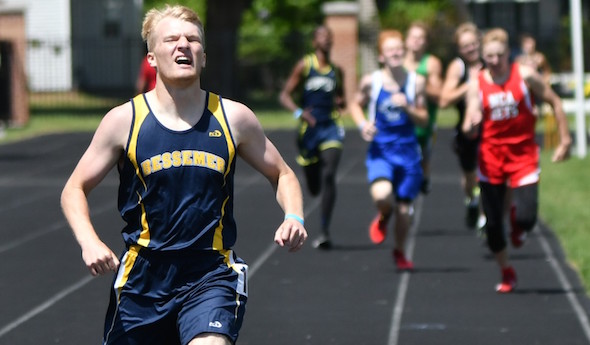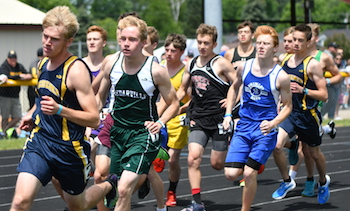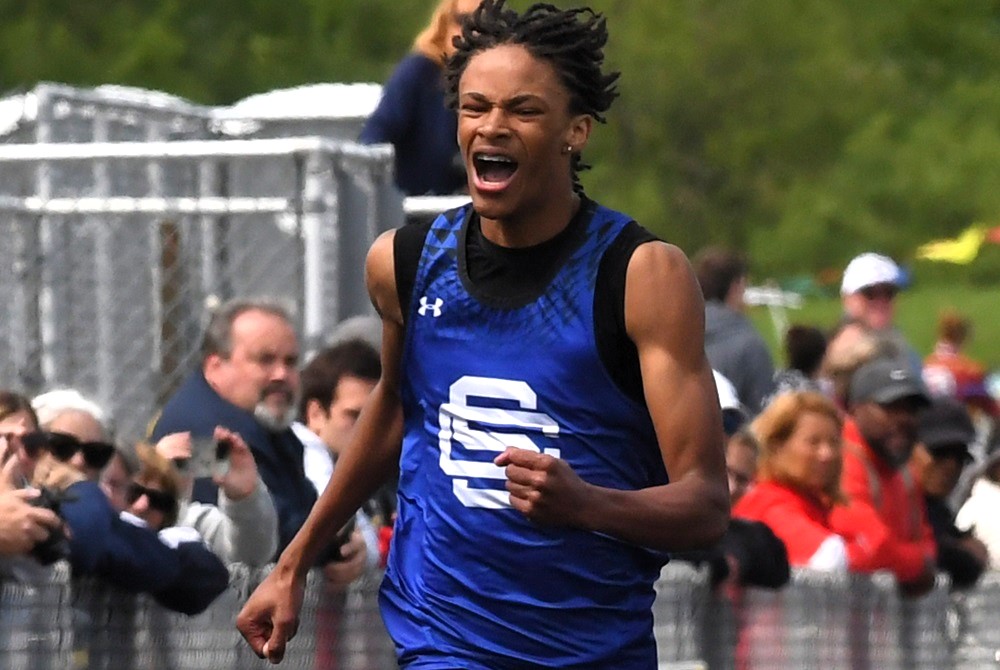
Bessemer Speediest for 1st Time since '51
By
John Vrancic
Special for MHSAA.com
June 3, 2018
KINGSFORD — It had been a long time since a Bessemer track team was last crowned Upper Peninsula champion.
A very long time.
The Speedboys changed that in convincing fashion Saturday, scoring 151 points for their first title since 1951, when they were competing in Class C.
Two-time reigning champ Rapid River was runner-up this time with 84 points, and Pickford took third at 45 in the U.P. Division 3 Finals at Flivver Field.
“Last year we lost by four points after winning every meet before the Finals,” said Bessemer assistant coach Tracy Rowe. “We were pretty hopeful coming in here. Our depth helped us out.”
The Speedboys won the first four running events and finished with nine firsts.
They began their quest with a victory in the 3,200-meter relay, covering the eight-lap race in 8 minutes, 31.15 seconds.
“The 3,200 relay set the tone for the day,” said assistant coach David Rowe. “We emphasized concentrating on the present, and the guys weren’t intimidated. This is something everybody was a part of. Our cross country team (co-op Gogebic Miners) won the U.P. (Division 2) title last fall, and the distances are where we racked up the points.”
Senior Isaiah Aili set a U.P. meet record in the 800 at 2:01.08, topping the previous mark (2:01.45) by Munising’s Brett Hannah run three years ago.
“I knew it was a big race, and there was a lot of competition,” said Aili, who was runner-up in the 1,600 (4:45.66). “I thought to myself, ‘I don’t want to lose this race.’ This means a lot to our school, team and coaches who have been there for us all year.”
Aili also helped the Speedboys win the 1,600 relay (3:37.74), as did senior Brayden Tomes, who took the 100 (11.92), 200 (23.7) and 300 hurdles (41.94).
“I can’t think of a better way to end my career, especially with all my teammates,” said Tomes. “This has been our goal since last year. We wanted to come back here and take the title.”
 Uriah Aili added a first in the 3,200 (10:25.29) and took second in pole vault (11-6), and sophomore Jamie Jett captured the 110 hurdles (16.97), took second in the 300 hurdles (44.11) and anchored the winning 800 relay (1:36.72), nipping Rapid River sophomore Tyler Sundling at the wire.
Uriah Aili added a first in the 3,200 (10:25.29) and took second in pole vault (11-6), and sophomore Jamie Jett captured the 110 hurdles (16.97), took second in the 300 hurdles (44.11) and anchored the winning 800 relay (1:36.72), nipping Rapid River sophomore Tyler Sundling at the wire.
“One of the negative things is our handoffs weren’t as good as usual,” said Jett, who made up a 10-15 yard deficit in the anchor leg. “I like that distance (200 meters). I think 100 meters is a little too short, and I die a little in the end of a 400. I had a good start and used the three-step in the hurdles. I’ve been working on that, and I find it increases my speed (over the four-step).”
Junior Andy Aspinwall was also part of the 800 relay, and Tyler Busch added a first in shot put (46-6).
“We knew it would be real close with (Rapid River),” said Aspinwall. “I think they were our best competition. They’re a real good team.
“It’s awesome to go home with the U.P. title.”
Rapid River senior Logan Hardwick earned his third straight discus title (144-11), and junior teammate Gunnar Larson was runner-up (138-11).
Classmate Lucas Sundling won the 400 (53.06), followed by Tyler Sundling (54.0).
Cedarville sophomore Thomas Bohn set a U.P. meet record in the 1,600 (4:33.24), shaving 77 hundredths of a second off the previous best by Rapid River’s Tyler Crossman (4:34.01) in 2008.
“I knew I had to go out hard and tried to set the pace early,” said Bohn. “I knew there would be a lot of good runners. Bessemer especially had good runners. They have a good program.”
Bohn was runner-up in the 800 (2:02.8) and 3,200 (10:37.25).
PHOTOS: (Top) Bessemer’s Isaiah Aili outdistances the field in the 800. (Middle) The pack takes a turn during the 1,600. (Photos by Cara Kamps. Click for more at RunMichigan.com.)

Performance of the Week: Southfield Christian's Brock Morris
June 5, 2025
 Brock Morris ♦ Southfield Christian
Brock Morris ♦ Southfield Christian
Senior ♦ Track & Field
Morris finished an individually-phenomenal day at Saturday's Lower Peninsula Division 4 Finals by helping his teammates make school history. With Southfield Christian trailing leader Kalamazoo Hackett Catholic Prep by three points heading into the final event of the day, Morris anchored the Eagles' 1,600 relay and crossed the finish line first – which, combined with Hackett's third-place finish in the race, gave Morris and his teammates their school's first Finals team championship in track & field by one point.
That victory capped a day that also saw Morris win the 200 and 400-meter open races and run on the winning 800 relay as well. Morris was part of school records in all four of those races this season and the 400 relay as well; the 1,600 relay time of 3:24.36 on Saturday lowered that school record and also included Dylan Taylor-Wilkerson, Robert Brown and Jadon Staten. Morris also ran cross country and played point guard on the boys basketball team. He will study at University of Michigan, majoring in biology, health and society on a pre-medical track.
@mhsaasports 🏃♂️POW: Brock Morris #southfieldchristian #track #finals #winner #1600relay #anchor #part1 #highschoolsports #tiktalk #interview #performanceoftheweek #mistudentaid #fyp #MHSAA ♬ original sound - MHSAA
@mhsaasports 🏃♂️POW: Brock Morris #instagram #chocolatemilk #hidden #talent #emoji #part2 #performanceoftheweek #mistudentaid #fyp #MHSAA ♬ Monkeys Spinning Monkeys - Kevin MacLeod & Kevin The Monkey
Follow the MHSAA on TikTok.
MHSAA.com's "Performance of the Week" features are powered by MI Student Aid, a division within the Department of Lifelong Education, Advancement, and Potential (MiLEAP). MI Student Aid encourages students to pursue postsecondary education by providing access to student financial resources and information. MI Student Aid administers the state’s 529 college savings programs (MET/MESP), as well as scholarship and grant programs that help make college Accessible, Affordable and Attainable for you. Connect with MI Student Aid at www.michigan.gov/mistudentaid and find more information on Facebook and Twitter @mistudentaid.
Previous 2024-25 honorees
May 30: Chloe Qin, Bloomfield Hills Cranbrook Kingswood tennis - Report
May 23: Drew Goik, Bay City Western golf - Report
May 15: Sydney Kuhn, Saginaw Swan Valley track & field - Report
May 8: Ryan Bosch, Fruitport baseball - Report
May 1: Jackson Lam, Kalamazoo Loy Norrix track & field - Report
April 25: Isabelle Horvath, Bangor softball - Report
April 18: Presley Jones, Sterling Heights Stevenson soccer - Report
April 11: Olivia Jasniewicz, Troy soccer - Report
March 27: Katie Spicer, Fowler basketball - Report
March 21: Moses & Markus Blackwell; Warren Lincoln basketball - Report
March 13: Keyshawn Summerville, Lansing Sexton basketball - Report
March 6: Maggie Buurma, Fowlerville wrestling - Report
Feb. 28: Maren Studt, Pontiac Notre Dame Prep skiing - Report
Feb. 21: Olive Krueger, Marquette swimming - Report
Feb. 14: Hunter Lemmon, Fraser swimming - Report
Feb. 7: Aubrey Hillard, Rochester competitive cheer - Report
Jan. 31: Wyatt Spalo, Reed City wrestling - Report
Jan. 24: Olivia Flynn, Harbor Springs basketball - Report
Jan. 17: Levi Rozema, Holland Christian swimming - Report
Jan. 10: McRecco McFadden, Burton Bentley basketball - Report
Dec. 18: Nash Leonard, Bay City Western hockey - Report
Dec. 11: Blake Cosby, Dundee wrestling - Report
Dec. 4: Keaton Hendricks, Zeeland West football - Report
Nov. 29: Kate Simon, East Grand Rapids swimming - Report
Nov. 22: Ella Kokaly, Essexville Garber volleyball - Report
Nov. 15: Caroline Bryan, Grosse Pointe South swimming - Report
Nov. 8: Kaylie Livingston, Whitmore Lake cross country - Report
Oct. 25: Oliver Caldwell, Grand Rapids West Catholic tennis - Report
Oct. 18: Alex Graham, Detroit Cass Tech football - Report
Oct. 11: Victoria Garces, Midland Dow cross country - Report
Oct. 4: Asher Clark, Bay City John Glenn soccer - Report
Sept. 26: Campbell Flynn, Farmington Hills Mercy volleyball - Report
Sept. 19: TJ Hansen, Freeland cross country - Report
Sept. 12: Jordan Peters, Grayling soccer - Report
Sept. 6: Gabe Litzner, Sault Ste. Marie cross country - Report
Aug. 30: Grace Slocum, Traverse City St. Francis golf - Report
(Photo by RunMichigan.com.)

